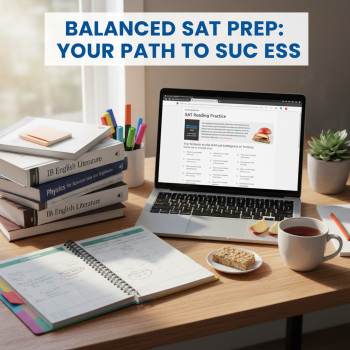When your Digital SAT score feels like a setback, it doesn’t have to be the story
Take a breath. If your Digital SAT score landed below what you were hoping for, you’re not alone—and you definitely still have strong options. The college application process is a lot more than a single number. Admissions teams look for growth, context, curiosity, and fit. The rest of your application can shine in ways that balance or even outweigh one test result.

Understand what “below average” actually means for you
“Below average” is relative. It’s important to translate that number into a few practical realities so you can plan: where the score sits compared to national or school averages, which schools still consider you competitive, and whether a retake or alternative path is the fastest route forward.
Quick checklist to interpret your score
- Look at your section and overall scores to spot strengths and weaknesses.
- Compare your score to the middle 50% score ranges of the colleges you want (find this in each school’s admissions profile).
- Check whether your target colleges are test-optional, test-flexible, or require scores.
- Ask your counselor or use tools to see which majors and programs weigh the SAT more heavily.
Choose a strategy: retake, apply test-optional, or shift focus
There are three common paths students take when a score feels low. Your best choice depends on timing, resources, and how much you can realistically improve the score.
1. Retake the Digital SAT (if you can realistically improve)
If you have time and energy for focused prep, a retake can be the clearest way to change your application profile. Many students gain a meaningful number of points with targeted practice on their weaker areas.
- Focus on specific content areas instead of general study—bring your score report to identify the skills that need work.
- Use timed practice sections to build stamina; the digital format changes pacing and navigation strategies.
- Consider short, consistent sessions (30–60 minutes daily) instead of marathon cram days.
2. Apply test-optional or test-blind where appropriate
Many colleges now let you apply without SAT scores, or they’ll evaluate your application without looking at test results. When you choose this path, you replace the test with compelling evidence of readiness: grades, coursework, essays, recommendations, and meaningful activities.
- Strengthen your transcript with advanced or relevant coursework where possible.
- Write personal essays that show voice, resilience, and intellectual curiosity—stories can reveal more about you than a test score can.
- Ask recommenders for concrete examples of your growth and potential.
3. Pivot your list: target a balanced mix of reaches, matches, and safeties
Be realistic and strategic. Create a college list that includes schools where your current score fits within the middle 50% range (matches), a few where you’re slightly below (reaches), and some where you exceed typical admits (safeties).
Build the strongest possible application beyond your SAT
Admissions officers read hundreds—even thousands—of applications. When one component is lower, other parts of your application can consciously fill the gap. Think of your application as a portfolio of evidence: academic preparation, meaningful activities, voice, and context.
Academic transcript and course choices
- Rigor matters. Admissions teams value students who challenge themselves. If you can take a higher-level course or an advanced elective that aligns with your interests, do it.
- Academic improvement is compelling. If your grades rose after a rough patch, highlight that upward trend in your application or counselor recommendation.
Essays that tell the story behind the score
Use essays to show what a test can’t: curiosity, resilience, leadership, or unique perspective. A thoughtful narrative about how you learned from setbacks or pursued an interest deeply can be more memorable than a numeric score.
- Pick specific anecdotes—admissions readers love concrete detail and emotional honesty.
- Show growth. Explain what you learned and how you’ll apply it in college.
Letters of recommendation
Strong recommendations can translate classroom performance and character into compelling language for admissions officers. Ask teachers who know you well and can speak to your intellectual curiosity or improvement.
Extracurriculars, internships, and community engagement
Depth matters more than breadth. A multi-year commitment or leadership role in a club, community project, or job often carries more weight than many short-term activities.
- Highlight sustained contributions and what you accomplished or learned.
- Use the activities section and essays to connect your interests to programs at the colleges you’re applying to.
Use data and planning tools to refine your list
Make decisions rooted in facts. Build a spreadsheet or table that compares your transcript, SAT score, application deadlines, test policies, and the projected cost of attendance. Below is a simple example to get you started.
| College | Test Policy | Middle 50% SAT | Application Deadline | How you fit |
|---|---|---|---|---|
| Example State U | Test-Optional | 1050–1250 | Nov 1 | Match—strong GPA & strong extracurriculars |
| Private College A | Test-Flexible | 1200–1400 | Jan 1 | Reach—consider submitting SAT if improved |
| Regional College B | Test-Blind | N/A | Rolling | Safety—excellent fit with intended major |
Financial aid and scholarships: test scores aren’t everything
Many scholarships look for leadership, need, or talent rather than a single SAT number. Also, fee waivers and programs exist to reduce application barriers. Make sure to explore institutional scholarships and fee waiver eligibility early.
Practical actions to take now
- Check whether you qualify for application fee waivers and apply for them if eligible.
- Look for scholarships that prioritize demonstrated need, major, or unique talents.
- Use profile-building opportunities—research projects, certifications, or district programs—that can strengthen merit or need-based aid applications.
Timing matters: how to plan immediate next steps
When you get a score you don’t like, resist panic. Create a realistic timeline for decisions: retake windows, application deadlines, and scholarship cycles. Here’s a sample calendar you can adapt.
Sample two-month timeline (for students applying this cycle)
- Week 1: Review score report. Identify sections to improve. Update your college spreadsheet.
- Week 2–4: Start focused practice (or a short tutor program) and draft or revise essays. Contact recommenders early.
- Week 5: Decide whether to register for the next available Digital SAT date.
- Week 6–8: Finalize applications for test-optional schools and continue targeted prep if retaking.
Targeted prep: make practice count
Not all studying is equal. When improvement is your goal, quality beats quantity. Use practice that mimics the digital format and gives immediate feedback so you can iterate quickly.
High-impact study tactics
- Review the digital SAT score report and focus on the four content areas highlighted there.
- Practice with official digital practice tools and full-length adaptive practice tests when possible.
- Drill the question types that most commonly trip you up, then retest to measure progress.
- Simulate test-day conditions—time pressure, limited breaks, and device settings—for at least two full practice sessions.
When personalized help makes sense
Many students see the biggest gains when they get tailored instruction: targeted lessons, personalized practice plans, and a coach who knows how to translate a score report into action. If you’re juggling school, activities, and applications, a focused tutor can help you improve efficiently.
Sparkl’s personalized tutoring can fit naturally here—students often benefit from 1-on-1 guidance, tailored study plans, expert tutors who break down the digital format, and AI-driven insights that identify the exact question types to practice. When time is short, those structured, data-driven sessions can turn a few weeks of study into measurable improvement.
How to present a low score in your application narrative
Transparency plus context is powerful. If you choose to address a low SAT score, do it briefly and purposefully—don’t make it the centerpiece of your application. Show what you learned and the concrete steps you took afterward.
Example approach in an optional essay or counselor note
- One or two sentences explaining context (e.g., illness, family responsibilities, unfamiliarity with digital format).
- One or two sentences about actions taken (e.g., completed a prep plan, retook the test, improved grades, sought help).
- One sentence linking the experience to future readiness and fit for the college.
Recommendable portfolio additions that can offset a test dip
Think creatively about other ways to show readiness.
- Capstone projects or independent study papers relevant to your intended major.
- Competitions, published work, or presentations at local events or conferences.
- Consistent employment or volunteer roles that show responsibility and growth.
- Online coursework or certifications that show content mastery.
Real-world examples (short stories of plausible students)
Case 1: Maya, the upward trajectory. Maya scored below the school average on her first Digital SAT, but her junior-year GPA rose from 3.3 to 3.9 after switching to AP courses and taking a leadership role in her robotics club. She applied test-optional to a mix of schools, wrote an essay about her learning curve, and landed on a campus with strong engineering support.
Case 2: Jonah, the focused retaker. Jonah’s math section was the main weakness. He did six weeks of targeted work—focused drills on algebraic reasoning and two timed practice tests—then improved by 80 points. He submitted the new score and paired it with a research internship that highlighted his problem-solving skills.
Case 3: Amira, the portfolio builder. Amira’s score didn’t improve after a retake, so she leaned into other evidence: a community health internship, a polished set of essays about service, and two glowing teacher recommendations. She applied to test-blind and test-optional schools and received multiple acceptances.
How parents can be supportive (without overstepping)
Your role can be steady and strategic. You don’t have to fix the score—help your student create a practical plan, provide emotional support, and help with logistics (deadlines, fee waivers, and scheduling).
Useful things parents can do
- Help create and maintain a calm timeline of tasks and deadlines.
- Encourage consistent, focused study over last-minute cramming.
- Arrange quiet study space and the tech setup needed for digital practice.
- Talk through college preferences and visit or attend virtual open days to assess fit beyond numbers.
Final checklist: actions to take this week
- Download and study your digital SAT score report to identify the weakest content areas.
- Update your college spreadsheet: test policies, deadlines, and fit categories.
- Decide whether to apply test-optional, register for a retake, or both.
- Reach out to recommenders early and draft personal statement ideas.
- Consider short-term 1-on-1 tutoring if you need targeted improvements—personalized plans often accelerate progress.
Wrapping up: the score is a detail, not the definition
Your Digital SAT score is a datapoint, not a verdict on your potential. Admissions officers want students who will thrive on campus: curious learners, thoughtful contributors, and resilient people. Whether you retake, apply test-optional, or fortify other areas of your application, a thoughtful plan—rather than panic—will serve you best. Use tools to compare fit, tell your story honestly, and invest time in the parts of the application you control.
And remember: targeted, personalized help—like focused 1-on-1 tutoring and data-driven study plans—can make the difference between spinning your wheels and seeing measurable improvement. There are effective ways to move forward that honor your strengths, your story, and your goals.

If you want help building your plan
If you’d like, we can map your score to a tailored action plan: whether that means a retake timeline, a list of test-optional colleges that match your interests, or a step-by-step application calendar. Small, focused steps lead to big changes—let’s make a plan that fits your life and goals.
Good luck—you’ve already taken the first important step by asking how to move forward. Keep going.

















No Comments
Leave a comment Cancel